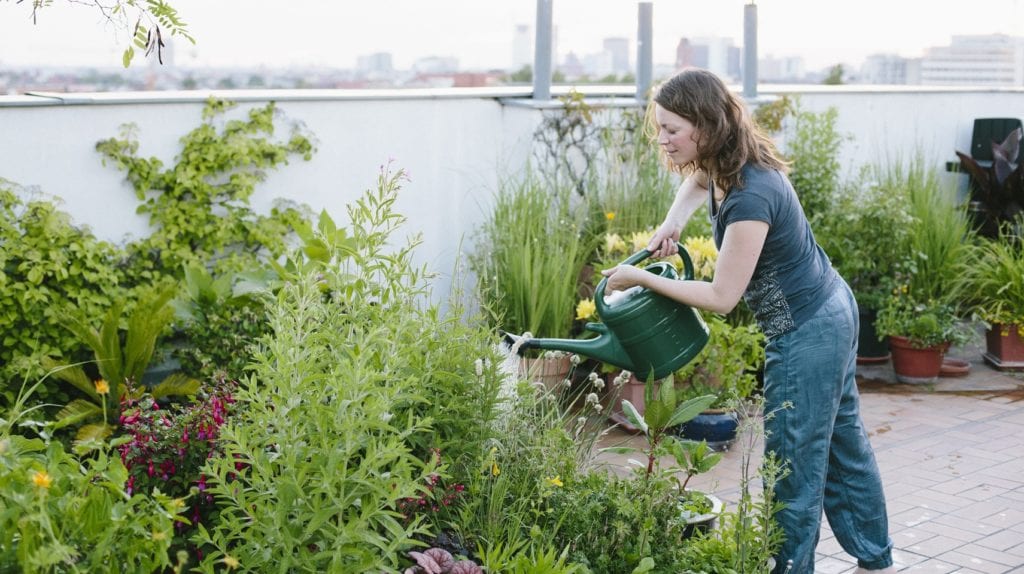Enjoy a rooftop garden that is both beautiful and eco-friendly

Photo: GettyImages/fotografixx
Take your passion for sustainability to the next level — literally.
Green roofs provide a myriad of benefits to homeowners, ranging from lowering energy costs to the psychological benefits that come from additional access to green spaces. With the help of a professional, you can create a green roof that will thrive in almost any climate.
Laying the Groundwork
According to Green Roofs for Healthy Cities, a company that promotes the construction of green roofs in urban environments, “A green roof system is an extension of the existing roof, which involves a high-quality waterproofing and root repellant system, filter cloth, a lightweight growing medium and plants.”
You should consult with a professional to design a green roof that will maximize your energy savings and fit your design goals. “A common misconception with green roofs is that they must always be green and vegetative,” says Chris Psencik, a green roof specialist with the Professional Landcare Network (PLANET). Psencik notes that rock gardens are often used in situations where irrigation is impossible or where irrigation would be impractical.
Though green roof popularity in North America is lagging compared to its European counterparts, enthusiasm for green roofs is catching on in America. “We are starting to see an increasingly larger amount of projects that are not only exploring the options of a green roof, but in some cases requiring a green roof,” says Psencik.
Plant the Seeds, Reap the Reward
Green roofs help to beautify a concrete jungle, providing additional green spaces for residents to enjoy. “Green space is a commodity in an urban environment … (it’s) something everyone needs and is looking for these days,” says Psencik.
The benefits go far beyond appearance, however. Roofs are the site of the greatest heat loss in the winter and the hottest summer temperatures. Green roofs help to regulate and insulate against these extreme temperatures, lowering energy costs.
Green roofs also contribute to landfill diversion, reduce outside noise, help manage storm water runoff, moderate the urban heat island effect, improve air quality and provide a new space for amenities such as rooftop gardens.
Anatomy of a Green Roof
Much like a rug, an extensive green roof is placed over a flat area of a roof that receives little foot traffic. Consisting of several different layers, a green roof system can be customized to fit almost any environment.
When planning your strategy, consider the different microclimates on your roof resulting from your roof’s orientation and surrounding structures. For example, the west side of your roof will receive more heat and sunlight, while the north side will bear the brunt of cold northern winds and be more affected by freezing temperatures. Overhangs will create shade gardens while any mirrored glass will exponentially increase radiant heat in its vicinity.
According to Green America, a nonprofit organization dedicated to ethical consumerism, “If your roof is flat or no more than 30 degrees sloped and in a sunny location relatively unshaded by trees, then you might be able to green roof your home.”
Keep in mind that you’ll likely need to reinforce your roof to support the added weight of the soil and plants. You can talk with your builder about this possibility since they know the dynamics of your home’s structure. If you’re still in a resale home, the cost of residential green roofing generally ranges from $12-$35 per square foot and should be installed by a professional.
Is a Green Roof the Right Choice for Your New Home?
Chris Knierim, winner of the bronze A’ Design Award for Landscape Planning and Garden Design Category for 2013-2014, notes that his award-winning design uses green roofs and vertical gardens to blend in with the local environment.
His design features drought-tolerant plants and a drip feed irrigation system to create a rooftop garden that exists in perfect harmony with the surrounding area.
“Due to the insulating benefits of the gardens, the thermal performance of the house has not required the use of any mechanical heating or cooling, which reduces the electricity consumption, in turn minimizing its carbon footprint on the environment,” he notes.
If installed correctly and tailored for the climate in which you live, a green roof can be a low-maintenance garden for you to enjoy. You’ll save on energy costs while helping create a more sustainable environment. Simply lay the ground work, plant the seeds and watch your personal rooftop paradise flourish. Be sure to speak with your builder about the possibility of including a green roof on your new home.

Seve Kale is an award-winning freelancer writer and former content intern for NewHomeSource. She graduated from the University of Texas at Austin in December 2013 with a degree in Government, Humanities and Spanish.
Prior to working with NewHomeSource, she interned in the Press Section at the U.S. Embassy in Buenos Aires and traveled extensively throughout South America

 How to Build a Cost-Effective Green Home
How to Build a Cost-Effective Green Home